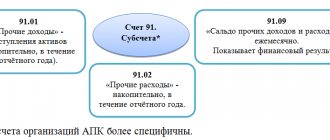What the law says
Today, an increasing number of companies and individual entrepreneurs are actively using the services of the bank under the simplified tax system “income minus expenses”. At the same time, credit institutions provide their simplified clients with a fairly wide range of services. Accordingly, the question arises about the tax accounting of bank expenses under the simplified tax system “income minus expenses”.
Clause 1 of Article 346.16 of the Tax Code of the Russian Federation lists costs that, in the final calculation, reduce the unified tax on the simplified tax system. Subclause 9 of this norm deals with the costs of bank services under the simplified tax system.
If we interpret it literally, then the costs of banking services under the simplified tax system include 2 items:
- Established bank interest under the simplified tax system “income minus expenses” for the use of loans and borrowings (without restrictions).
- Costs of paying for services of credit institutions (without restrictions).
In practice, the simplification can be applied to both banks and non-bank credit institutions. So: The Tax Code does not make any division in this regard. That is, the costs of servicing a bank under the simplified tax system also include contacting a credit institution that does not have the status of a bank.
How to use money from a current account
To receive money from the business, the founders of the LLC set their own salaries and receive dividends from profits once a quarter. They also take out interest-free loans from their own company.
You can withdraw money through an individual entrepreneur - the founder is registered as an individual entrepreneur and provides company management services. If you choose a simplified taxation system, the tax will be 6% of income.
Individual entrepreneurs freely spend from their current account for personal needs. To avoid confusion in tax reporting, it is better to link a corporate card to your account. Individual entrepreneurs use it to pay for purchases and withdraw cash. Restrictions are imposed only when the individual entrepreneur has debts to the state.
Scroll
Based on Article 5 of the Law “On Banks and Banking Activities” No. 395-1, banking services may include the following:
- attracting funds from a company/individual entrepreneur using the simplified tax system for deposits (on demand and for a specific period);
- placing this money on your own behalf and at your own expense;
- opening and maintaining simplified bank accounts;
- money transfers on behalf of a simplifier;
- collection of currency, bills, payment and settlement documents;
- simplified cash service;
- issuance of bank guarantees;
- electronic money transfers.
For any of these operations, the bank’s commission under the simplified tax system “income minus expenses” can be attributed to expenses. In this case, the bank commission is included in the expenses under the simplified tax system, regardless of its size established by the credit institution.
Many simpletons purchase corporate cards. Usually they help speed up and simplify various calculations within the framework of business and/or core activities. So: for transferring funds to corporate cards, bank commissions can also be included as expenses under the simplified tax system. As well as the fee for issuing a check book.
In addition, banks can carry out a number of transactions. There is no complete list in this law. However, here are the most popular ones:
- issuance of guarantees for the simplified person, which provide for the fulfillment of monetary obligations;
- acquisition of the right to demand from third parties the fulfillment of monetary obligations;
- trust management of money and other property of the simplifier;
- leasing to a simplifier special premises or safes for storing documents and valuables;
- leasing operations;
- Providing consulting and information services to the simplifier.
Also see “List of expenses under the simplified tax system “income minus expenses”: table for 2021 with explanation.”
How to cash out money from an LLC current account
When an organization needs cash, it is withdrawn in one of seven ways:
- For household needs up to 100,000 rubles. You usually do not have to report expenses, but it is advisable to keep documents that support expenses.
- For salaries. The withdrawal of money is confirmed by an order for the employee to be hired, a completed work book or employment contract, a time sheet and a salary slip.
- For dividends. The founders of an LLC can withdraw dividends once a quarter. Dividends are paid from net profit.
- For business trips. Ticket and hotel reservations are confirmed.
- For entertainment expenses, for example, holding events.
- For loans to founders or employees with any repayment period. The debt can then be forgiven, but the recipient then pays 13% income tax on the amount.
- For accountable expenses. For example, an office manager went to repair a water cooler for cash. The LLC confirms the expense with a check.
To receive cash, a legal entity opens a checkbook. When he decides to cash out, the bank will write in the book:
- date of operation;
- amount of money;
- Full name and passport details of the recipient;
- signature;
- purpose of money.
Cash withdrawal fees vary and depend on the bank.
Costs for the “bank-client”
A separate conversation with the inclusion of “bank-client” services as an expense under the simplified tax system. Tax officials believe that simplifiers can include only those services of a credit institution provided by it within the framework of the “client-bank” system, which we list above, as expenses. That is, they are directly named in Art. 5 of the Law “On Banks and Banking Activities” No. 395-1 (letter of the Federal Tax Service dated July 28, 2005 No. 22-1-11/1451).
And vice versa: it is impossible to reduce the single tax on services for the installation and operation of electronic document management systems between the bank and the simplified bank, since they are not named in the law. In particular, we are talking about the “client-bank” system.
Also see “Organizing a salary project: essence and agreement.”
Read also
17.04.2017
What will change if the bank becomes a client?
Here many people are wondering, since the law only clarifies the case when it comes to “client-bank” transactions. There is an opinion among tax experts that it would be appropriate to use the reverse procedure of Article 5 of the Banking Law No. 395. In other words, business entities have the right to take into account only services declared under the “client-bank” system. Other species should not be taken into account.
Similar articles
- Expenses under simplified tax system 15: recognition procedure 2017
- How to reflect the receipt of payment for the services of an individual entrepreneur on the PSN after his transition to the simplified tax system?
- Representation expenses under the simplified tax system “income minus expenses”
- Rules for accounting for intangible assets by enterprises using the simplified tax system
- USN expenses accepted for taxation 2017
Are all commissions included in expenses under the simplified tax system? Bank commission costs are high.
No, it's illegal.
The bank’s actions to open and maintain a loan account cannot be qualified as an independent banking service.
Banks are required to maintain accounting records in accordance with the Federal Law “On Accounting”, the Law on Banks, the Law on the Central Bank of the Russian Federation (Bank of Russia), as well as the Regulations of the Central Bank of the Russian Federation “On the Rules for maintaining accounting records in credit institutions located in the territory of Russian Federation".
The obligation to open and maintain a loan account, as well as conduct transactions on it, is established by the legislation of the Russian Federation, i.e. has a public legal nature. It follows from this that a loan agreement (like any other agreement) cannot provide for the collection of fees for the bank’s performance of its public legal obligation to maintain accounting records, since this is not a service provided to the borrower.
The term “loan account” is not defined by law, although it is used in a number of regulatory legal acts. However, in fact, a loan account means a group of accounting accounts and debt for loan repayment.
In Bank of Russia Instruction No. 28-I dated September 14, 2006 “On opening and closing bank accounts, deposit accounts,” which provides an exhaustive list of types of bank accounts, there is no mention of a loan account.
Loan accounts are not bank accounts within the meaning of the Civil Code of the Russian Federation.
When lending, the bank opens a loan account, which is not an account in the sense of a bank account agreement. The loan account serves to reflect the debt of the borrower to the bank for loans issued and is a method of accounting for cash and material assets.
The actions that the bank is obliged to take to create conditions for the provision and repayment of a loan (the bank's creditor obligation) are opening and maintaining a loan account, since such a procedure for accounting for loan debt is provided for by special banking legislation
An account for accounting for loan debt (loan account) is opened for the purpose of reflecting the debt of the bank borrower on loans issued and is a method of accounting for funds and is not intended for settlement transactions.
At the same time, opening a balance sheet account to account for loan debt is the responsibility of the credit institution on the basis of the above-mentioned regulations of the Central Bank of the Russian Federation and clause 14 of Art. 4 of Federal Law No. 86-FZ of July 10, 2002 “On the Central Bank of the Russian Federation (Bank of Russia)”, in accordance with which the Bank of Russia establishes accounting and reporting rules for the banking system of the Russian Federation.
The mandatory opening of a current credit account by a bank for a borrower is not provided for by law, and maintaining a loan account is the responsibility of the bank, but not to the borrower, but to the Bank of Russia, which arises by force of law.
In accordance with paragraph 2 of Art. 16 of the Law of the Russian Federation “On the Protection of Consumer Rights” it is prohibited to condition the purchase of some services on the mandatory purchase of other services. Losses caused to a consumer borrower as a result of violation of his right to free choice of services are assigned to the unscrupulous lender.
What is a current account
According to the law, you can work without cash settlement services, but only with cash. If an entrepreneur works without an account, he faces a number of restrictions:
- does not enter into a contract for more than 100,000 rubles,
- do not accept card payments,
- inconvenient to pay taxes.
And organizations also receive a fine for overstocking the cash register.
The cost of service depends on the bank. When an entrepreneur chooses a tariff for a business, he compares how much it costs to open an account in different banks, the amount of commissions and other parameters.
To receive money from the current account, the founders of the LLC pay themselves a salary. They also pay dividends on profits once a quarter. Individual entrepreneurs link a personal card to their account and can freely transfer money to it.
If the LLC needs cash, it is withdrawn through the bank. You need to indicate for what purposes cash is required, and then confirm the transactions for the tax authorities with checks and contracts. A fee is charged for cashing out.
To replenish their current account, organizations take out a loan or accept money as a gift from the founder. Individual entrepreneurs can freely replenish it from a personal card.
Be sure to like (thumbs up) this article if you liked it. Subscribe to the channel so as not to miss new publications! Thank you for reading to the end! The article is available on our website at: https://tvoedelo.online/rko/raschetnyy-schet-chto-takoe
How much does a checking account cost?
Business owners pay banks for creating and maintaining cash settlement services. The abbreviation stands for “cash settlement services”. It includes:
- sending money between a businessman and his counterparties,
- currency operations,
- accepting and issuing cash,
- Internet acquiring.
The price of the service depends on the bank. Individual entrepreneurs and legal entities choose favorable terms of service taking into account their requests. For example:
- how much does it cost to open an account and connect to online banking;
- what is the subscription fee for the service;
- what is the bank’s commission for payments, deposits, and cash withdrawals;
- Does the bank charge a fee for transferring to a personal card - for individual entrepreneurs.
Tags: Bank, currency transactions, loan, tax, order, expense, simplified tax system
Limitations when using a personal account
Individual entrepreneurs can use a personal card for business transactions. But the Central Bank prohibits banks from conducting business-related transactions through regular cards. Therefore, the money transfer may not go through.
For counterparties, transferring money to an individual means paying income tax and sending unnecessary reports.
The individual entrepreneur will have confusion in his reports - he will have to prove that not all receipts on his card are income. Otherwise, you will have to pay income tax on gifts and other income not related to the business.
With a current account, entrepreneurs accept non-cash payments, connect electronic payment systems, enter into long-term contracts for any amounts, pay taxes by bank transfer and send excess cash to it.
Income from barter transactions
Income received from barter transactions should be reflected in the book of income and expenses at the moment when the counterparty fulfilled its obligations to the organization under the barter (commodity exchange) agreement. That is, when the counterparty transferred the relevant goods (other property) to the organization. This follows from paragraph 1 of Article 346.17 of the Tax Code of the Russian Federation.
Situation: when to reflect income from barter transactions in the ledger of income and expenses? Property from the counterparty was received in one month, the organization’s property was transferred in another
Income from barter transactions should be reflected in the book of income and expenses after the ownership of the received property has transferred to the organization.
This is explained by the fact that property obtained not under the right of ownership is not income of the organization (Article 41 of the Tax Code of the Russian Federation).
Paragraph 1 of Article 346.17 of the Tax Code of the Russian Federation states that the date of receipt of income is the moment of receipt of property. From the provisions of this paragraph, we can conclude that income from barter transactions is reflected in the book of income and expenses on the day when the organization receives property from the counterparty.
However, with barter, the parties to the contract receive ownership of the exchanged property at the same time, after fulfilling their obligations to each other.
You can deviate from this rule if the contract specifies a special procedure for transferring ownership. If there are no special clauses in this regard, all received property belongs to the counterparty until the organization transfers its property to him. This is stated in Article 570 of the Civil Code of the Russian Federation.
The above rules also apply to autonomous institutions, since property acquired by the institution under an agreement (other reasons) enters the operational management of the institution in the manner established for the acquisition of property rights (clause 2 of Article 299, Article 570 of the Civil Code of the Russian Federation).
Methodologically, this position seems more justified. However, there are no official explanations from regulatory agencies on this matter.




